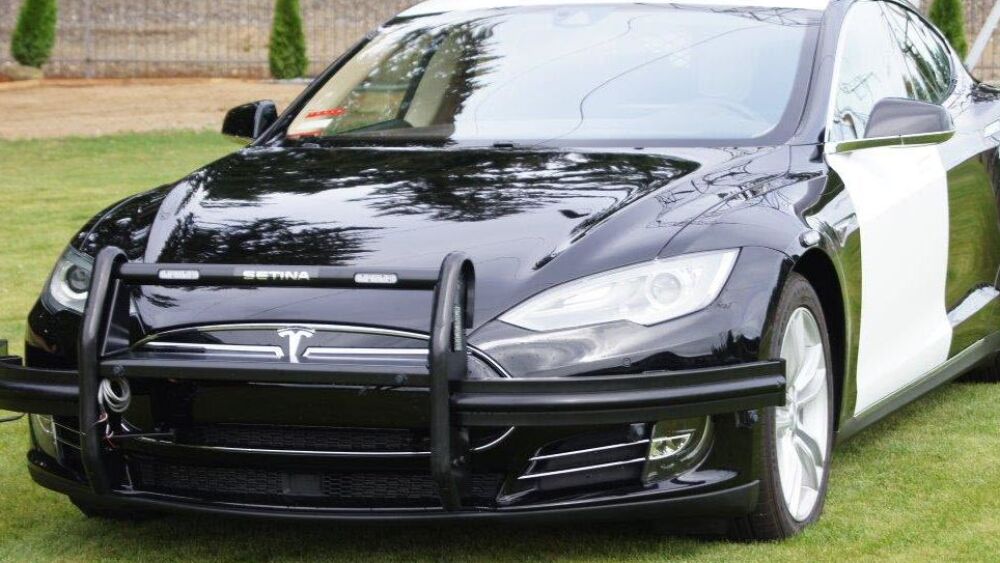While many police departments are showing off Tesla police cars converted from vehicles that were donated, confiscated, or purchased, most of them are showpieces driven by top brass and shown off at community events.
In contrast, because of their experience with eight Ford Fusion Hybrids used for command staff and admin lieutenants, the Fremont Police Department (FPD) believed there could be substantial savings in terms of fuel and maintenance by putting a fully EV (electric vehicle) into service as a patrol vehicle.
FPD delivered a check to Tesla in January 2018 to purchase a used 2014 Tesla Model S 85 and turned it over to LEHR Auto in Sacramento. LEHR relied upon its extensive knowledge of outfitting first responder vehicles – along with additional technical support from Tesla – to transform the Tesla into a standard cruiser.
As you can see by the photos, car 548 is no more a show car than a Malinois K9 is a show dog. It is configured and treated like any other cruiser, working up to 11 hours in two shifts a day. In addition to the standard rear trunk, the Tesla also has a front trunk, referred to as a “frunk,” which provides additional storage space.
While the front seats are stock Tesla, modifications to cruiser #548 include:
- Additional 12v battery to support the electrical load;
- Front, rear, wheel well and overhead light bars;
- Motorola WatchGuard in-vehicle camera;
- Trunk lighting;
- Panasonic mobile digital computer;
- Setina push-bumper with spotlight;
- Setina prisoner seat and partition;
- Center radio and electronics stack;
- Armormax door panels in the front doors.
Because of the extensive number of cameras and sensors on a Tesla, installation of the LE components required more intricate assembly and relocation of the bumper-mounted distance sensors. Setina Manufacturing modified existing products while other products were designed from scratch for the project. For example, the prisoner seat was modified from Setina’s stock Dodge Charger seat. Setina does offer other custom products for the Tesla Model S (and soon for the Model Y).
What was Tesla’s involvement in the project?
While Tesla’s U.S. factory is a couple of miles down the road from Fremont PD, Brett Ware, National Sales Manager for Setina Manufacturing, told us that their support was slower than traditional LE vehicle suppliers. He believes this was because there was an initial learning curve for both companies in getting acquainted with upfitting Teslas for police use. They quickly came up to speed together however, and support was quick, thorough and enthusiastic. This momentum continued on to the upcoming release of Fremont PD’s Model Y, which is due out on the streets in the fall.
PD charging station
As part of an effort to make Fremont sustainable, in 2015 an 872kW solar carport structure was installed at the Police Department, which now supports two Tesla Level 2 charging stations in addition to powering other loads.
The charger takes 2-4 hours to bring the car from 50% to its police duty range of 160 miles, which is lower than the normal OEM maximum range of 265 miles. The energy cost per mile is $0.0794 which is $12.70 per charging cycle. Contrast this to FPD’s Ford Utility police pursuit vehicles, which have a normal OEM maximum range of 344 miles using an 18.5-gallon gas tank. Under severe police duty application, the normal OEM range is reduced to 153 miles and the fuel cost per mile is increased to $.364 for a fuel cost of $55.69.
The Tesla charging station is supplemented by existing on-campus electric vehicle charging stations, although they are substantially slower. A Tesla Level 3 Supercharger can charge an empty battery to 90% in roughly 45 minutes, but Fremont does not have one installed at this time.
The Tesla Model S 85 averages 50% power usage during a typical 11-hour patrol shift, easily accommodating the 40-70-mile range that Fremont patrol vehicles drive on average per day. These results provided confidence in the ability to deploy an electric vehicle for a standard 11-hour patrol shift.
While the assumption would be that an electric luxury vehicle would spend substantial time in the shop, Fremont’s experience did not bear this out. Tesla’s average annual maintenance downtime was 39.125 days (10.72%) versus the PPV’s downtime of 66 days (17.98%).
As anyone who follows Tesla knows, their cars are some of the quietest and fastest on the road in terms of 0-60 acceleration and the battery pack mounted at the bottom of the chassis creates a low center of gravity making the car nearly impossible to roll, even in hairpin turns. Fremont officers reported an enhanced feeling of safety and control, a reduction in anxiety and stress and improved radio communication due to the handling and lack of engine noise.
But could that battery run out during a pursuit? Yes, and it has done just that. During a stolen vehicle pursuit at the end of a shift, the Tesla gave way to other officers to continue while it was driven back home to be charged. But to be fair, a Crown Vic could run out of fuel, blow a tire, or pop a rod under the same conditions.
Model Y on the way
One of the challenges of the low-slung Model S is the height between the door sill and the top of the door. Drivers over six feet and those with back problems reported the position of the Tesla Model S 85’s “B pillar” made it more difficult to enter and exit the vehicle when compared to traditional Ford SUV police vehicles. Additionally, the size of the rear seat prisoner space in the Model S poses a challenge for larger prisoners due to the severely limited legroom as you can see in the photo.
For these reasons, Fremont PD has a Model Y crossover being outfitted that should be out on patrol sometime this fall. The key differences between the Model S and the Model Y are 4” more rear legroom, 7.8 cubic feet of additional cargo space and a much higher cargo bay, allowing for installation of a gun safe or a patrol sergeant’s writing and storage stack. While roomier on the inside, the Model Y is 9 inches shorter and 1.7 inches narrower than the Model S, letting it fit into tighter places.
We’ll be back shortly with details on and photos of Fremont PD’s Model Y.



